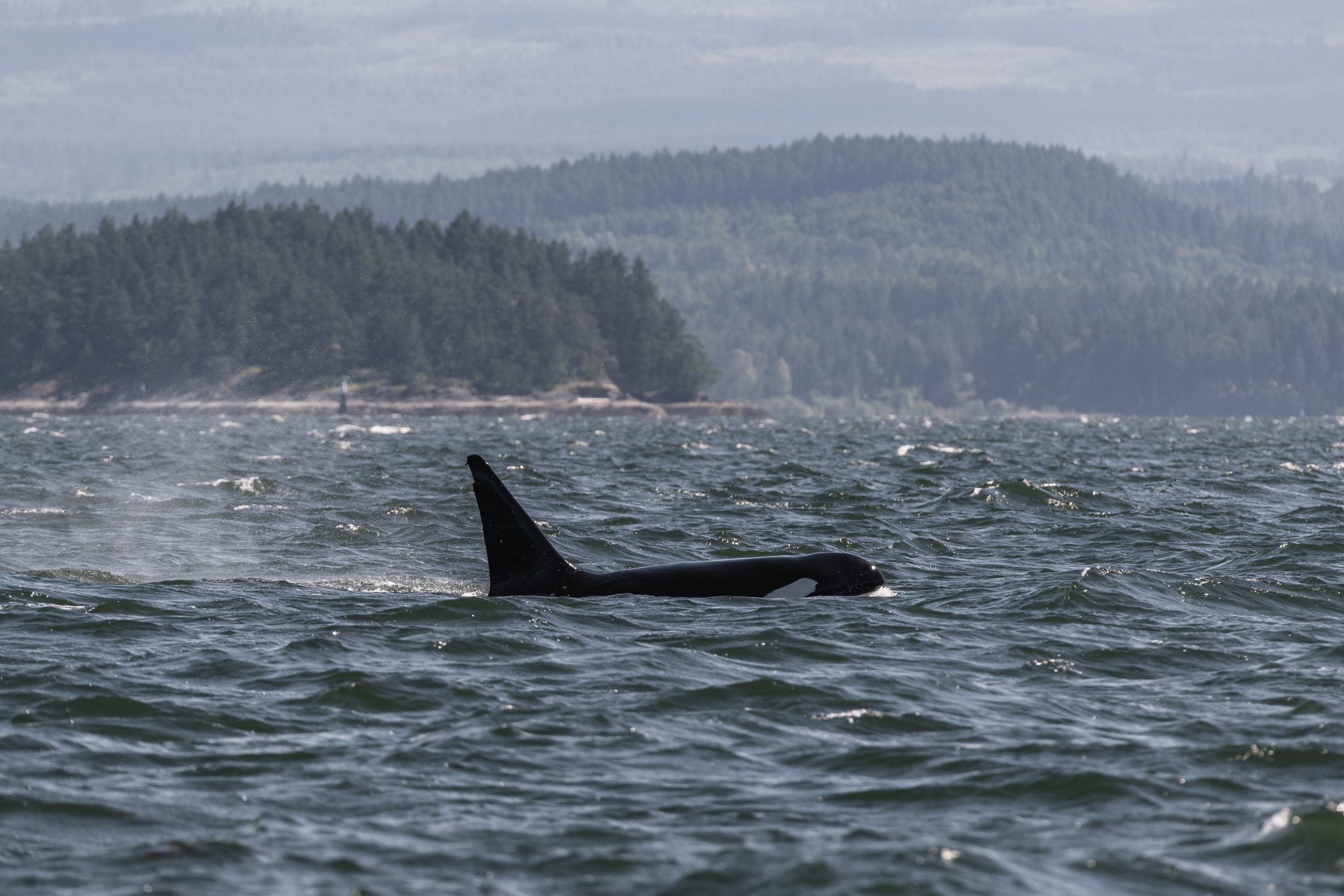May 29, 2025 - Wildlife, waves and whales!
We pushed off the dock with guests aboard Kula, our semi-covered vessel, and Cascadia, one of our open boats, both ready to search for whales. A bit of wind today made for a wet and wild ride, but sometimes this kind of weather works in our favour (we’ll come back to that shortly!).
To cover more ground, we sent the boats in different directions. It took a while to locate our whales, but in the meantime, we were entertained by some of our favourite pinniped residents.
First up, the ever-charming harbour seals. These incredibly adaptable marine mammals are often seen navigating rough, choppy waters with ease. Despite their agility at sea, they still need to come ashore, or "haul out", to rest, regulate their body temperature, and avoid predators. You’ll often find them lounging on rocky outcrops or sandy beaches, soaking up the sun and recharging before heading back into the surf.
Next, we spent some time with their much larger (and much louder) cousins, the Steller sea lions. Built for the wild, Steller sea lions are powerful swimmers that thrive in rough seas. Even in stormy conditions, they’re known to rest at the surface by forming “rafts”, groups of individuals floating together. Linked by flippers or drifting nearby, they conserve energy and stay socially connected, bobbing in the swells like buoys in the waves.
Speaking of boys in the waves—when we rounded Gabriola Island, we spotted a couple! This familiar pair is easily identifiable, as both have distinct notches on their dorsal fins. The orca present today were:
T087 Harbeson ♂ (~1962)
T124C Cooper ♂ (1992)
Now let’s get back to how the rougher seas help us out when we are watching whales. Choppy water often works in our favour. In rough conditions, whales are more likely to surface higher out of the water to breathe, giving us a better view of their bodies, not just their dorsal fins. They also have to fight against the waves, just like our vessels, which can result in larger splashes and more visible movement from a distance.
When we picture orca, we often imagine them slicing effortlessly through the ocean, sleek, powerful, and in control. But the sea isn't always calm. Even though orca are among the ocean’s top predators, perfectly built for strength and speed, they still feel the impact of rough water.
In choppy seas, orca expend significantly more energy to swim. Unlike calm water, waves create resistance and unpredictability, forcing them to engage more muscle groups and burn more energy. On average, an adult orca needs to consume about 300 pounds of food per day—roughly 150,000 calories—to meet their daily energy demands. That’s equivalent to what about 85 average humans would eat in a day, or nearly 200 hamburgers!
Navigating rough seas can increase their energy expenditure by as much as 30%, depending on the wave size and duration. That means more hunting, more movement, and more food needed to fuel their efforts. Fortunately, orca are highly adapted for this balance of survival, power, and grace. Every wave comes with a cost, but it’s a price they’re built to handle!
Enjoy the photos below by Marine Naturalists Aly Kohlman and Hayleigh Hilbert.
A harbour seal cuddle puddle. Photo by Aly Kohlman.
Stared at by seals. Photo by Aly Kohlman.
Sunning seals. Photo by Hayleigh Hilbert.
“You’d tell me if I had something on my face, right?” Photo by Aly Kohlman.
A pile of Steller Sea Lions. Photo by Hayleigh Hilbert.
An itchy Steller. Photo by Hayleigh Hilbert.
A BIG nap! Photo by Hayleigh Hilbert.
A Steller Sea Lion watching us watching him! Photo by Hayleigh Hilbert.
T124C Cooper. Photo by Aly Kohlman.
T124C Cooper surfing the waves. Photo by Hayleigh Hilbert.
T087 Harbeson followed by T124C Cooper with the B.C. Ferry in the background. Photo by Aly Kohlman.
T087 Harbeson in front of the Coastal Renaissance. Photo by Aly Kohlman.
T087 Harbeson. Photo by Aly Kohlman.
T087 Harbeson. Photo by Hayleigh Hilbert.
T087 Harbeson. Photo by Aly Kohlman.
T124C Cooper. Photo by Aly Kohlman.
T087 Harbeson with his best buddy T124C Cooper in tow. Photo by Aly Kohlman.
T087 Harbeson. Photo by Aly Kohlman.
T124C Cooper with T087 Harbeson. Photo by Aly Kohlman.
T124C Cooper followed by T087 Harbeson. Photo by Hayleigh Hilbert.
T087 Harbeson’s distinct dorsal tip, with T124C Cooper powering through the waves behind him. Photo by Hayleigh Hilbert.
T124C Cooper splashing through the surf! Photo by Hayleigh Hilbert.
T124C Cooper. Photo by Hayleigh Hilbert.
T087 Harbeson rushing through the water. Photo by Hayleigh Hilbert.
























